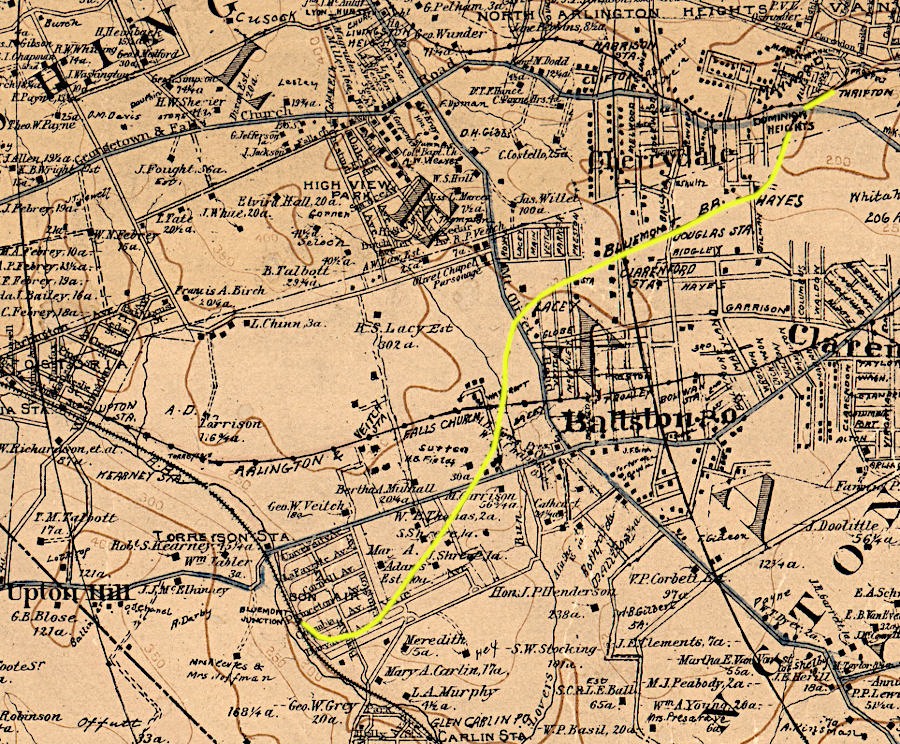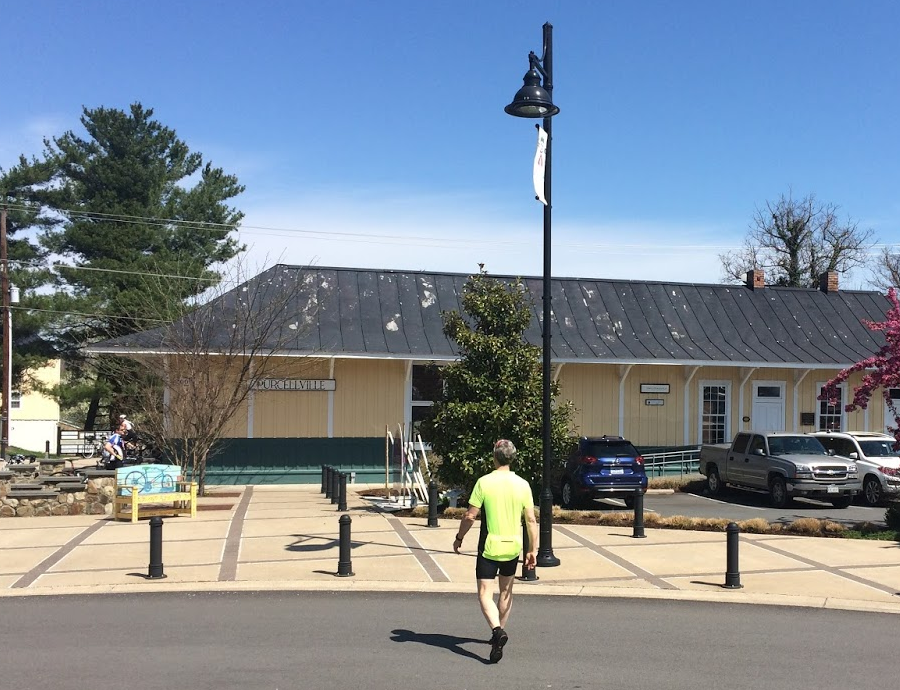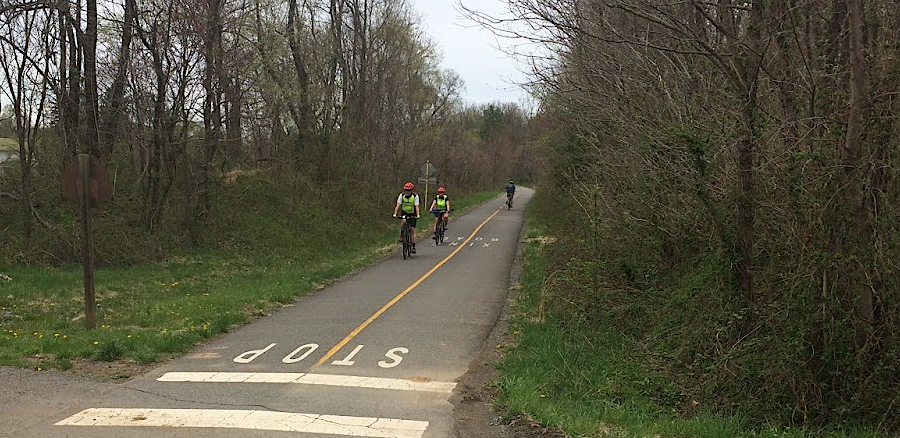
the Washington and Old Dominion Railway built three miles of new track (yellow) to connect to the Bluemont Branch in 1918
Source: Library of Congress, Baist's map of the vicinity of Washington D.C (1918)
pmccrayc, W&OD Railroad Film 1939
The Great Falls and Washington and Old Dominion Railroad received a charter on January 21, 1900. It was organized by local Arlington residents, through whose land the track was built.
A year later, they sold the company to John R. Mclean and Senator Stephen Elkins of West Virginia. They built an electric trolley line from Rosslyn to Great Falls, with the first trains running in 1906. Excursion travel to Great Falls Park was popular, and the line was double-tracked in 1908.
At Rosslyn, track over the Aqueduct Bridge carried passengers to Georgetown - but only one car at a time. Passengers had to transfer at Rosslyn to and from the main line.
The company was renamed the Washington and Old Dominion Railway in 1911.
In 1912, the Washington and Old Dominion Railway expanded by obtaining a 50-year lease of the track built originally by the Alexandria, Loudoun and Hampshire (AL&H) Railroad. At the time, the track extended 56 miles from Alexandria past Leesburg to Bluemont in the Blue Ridge. It was owned by the Washington, Ohio & Western Railroad, but was under a 999-year lease to the Southern Railway. The Southern Railway called it the Bluemont Branch.1
The Southern Railway retained control of the eastern 1.5 miles of old Alexandria, Loudoun and Hampshire (AL&H) Railroad track, from Potomac Yard to the Alexandria waterfront. The Southern Railway served industrial customers along that stretch, including the Robinson Terminal warehouse and a coal-fired electricity generating power plant.2
The Washington and Old Dominion Railway built three miles of new track from Thrifton to the newly-leased track. Once the Bluemont Junction was completed, the primary eastern end of the Washington and Old Dominion Railway was at Rosslyn. Some freight was pulled by steam locomotives to Alexandria on the segment of old Alexandria, Loudoun and Hampshire Railroad track, for interchange with other railroads.
Trains carried mostly passengers, including commuters going to and from Washington DC. Recreations trips for 14 miles from Georgetown to Great Falls Park, and for 52 miles from Georgetown to the Blue Ridge, generated most of the passenger revenue. Commuters also used the line to get from Herndon, Vienna, Falls Church and Dunn Loring to Washington, DC and back home in the evening. Property values rose as a result of train-supported suburban sprawl.
Freight, and an occasional passenger train, used the tracks from Bluemont Junction east for seven miles to Alexandria. 3

the Washington and Old Dominion Railway built three miles of new track (yellow) to connect to the Bluemont Branch in 1918
Source: Library of Congress, Baist's map of the vicinity of Washington D.C (1918)
All of the track from Rosslyn to the Blue Ridge was electrified in 1912, to serve passenger trains initially. Steam locomotives continued to carry freight on the Bluemont Branch for seven more years. The stretch from Bluemont Junction to Alexandria was electrified in 1918. The first diesel engines were purchased in 1941.
In addition to five fixed substations, a portable substation was used to supplement electrical power where need was greatest. Locomotives used an overhead catenary to get the necessary electricity for the motors which drove the wheels.
Trains to Bluemont traveled at an average of 20 miles per hour. Every morning a train ran the milk run, picking up cans of milk at each station. An evening train returned the empties from the Chestnut Farm Dairies in Washington, DC.
Sen. Elkins died in 1911, and John McLean in 1916. The heirs were not active managers, and railroad operations were haphazard. Customer complaints were common, and the employees were not known for their attention to schedules or polite service. The investment in electrification was not profitable.
The Great Depression reduced revenues substantially, starting in 1929. To reduce costs, the line to Great Falls was abandoned in 1934. The roadbed from Thrifton to Great Falls was transferred to Arlington and Fairfax County as payment for past-due property taxes. The rails were removed, and the route of the electric trolley became Old Dominion Drive.
In 1935, the Washington and Old Dominion Railway went through bankruptcy. Track from Thrifton to Rosslyn was retained, as was the original Alexandria, Loudoun and Hampshire Railroad track from Alexandria to Bluemont. The Potomac Yard expanded, eliminating the track of the Washington and Old Dominion electric railway there.
Davis Elkins, son of the late Sen. Stephen Elkins, purchased the assets and organized the Washington and Old Dominion Railroad in 1935. The track west of Round Hill was abandoned in 1939. Recreational trips to the mountain boardinghouses had declined, followed by closure of the flour mill at Round Hill and competition from trucks hauling apples to market.
In 1941, the railroad stopped offering passenger service. It began to abandon electricity that year, trading the copper wire from the catenary to the Southern Railway for three steam locomotives to haul freight. The Potomac Electric Power Company contract was cancelled in 1944, after conversion was complete. In 1943, the Federal government required restoration of passenger service to meet the peak needs during World War II. Passenger trains were kept in operation until 151, when that service was dropped again.
In 1944-45, Davis Elkins converted the 50-year lease from the Southern Railway into a purchase of the railroad. In 1954 he sold his ownership to the Chesapeake and Ohio (C&O) Railway. It did not absorb the Washington and Old Dominion Railroad; the railroad remained as an independent corporation.4
The Chesapeake and Ohio Railway planned to make a profit by hauling coal from Potomac Yard to a new electricity generating plant expected to be constructed at Sterling. However, the Potomac Electric Power Company chose to build the Dickerson Generating Station in Maryland, on the edge of the Potomac River where it would be served by the Metropolitan Branch of the Baltimore and Ohio (B&O) Railroad.
The construction of Dulles International Airport and the Capital Beltway (I-495) provided the last spurt of freight traffic on the Washington and Old Dominion Railroad. To support the traffic, new sidings were added, 13 trestles were replaced, and track was upgraded.
In 1965, after that business ended, the railroad asked the Interstate Commerce Commission (ICC) to approve abandonment. Three years of hearings led to ICC approval.
The Commonwealth of Virginia purchased four miles of the 100-foot wide right-of-way needed for construction of I-66. The rest was purchased by the Virginia Electric Power Company (VEPCO, now Dominion Energy) for a transmission line to increase the supply of electricity in the Northern Virginia suburbs of Washington, DC.5
The utility company purchased the rest of the 100-foot wide right-of-way, in a deal previously negotiated with the Virginia Department of Highways. Rail service ended in 1968, and rails were removed in 1969:6
The alternative to abandonment was preservation of the railroad right-of-way for transportation. One ICC judge who objected to the decision noted presciently:7
The old right-of-way crossed through three counties, four towns and one city, complicating any planning to reuse it. A regional organization, the Northern Virginia Regional Park Authority (today known as NOVAParks), was able to negotiate the bureaucratic complexities and create a linear park. It started with a one-mile section in Falls Church. The immediate popularity of the trail justified efforts to get VEPCO to donate an easement along its powerlines.
In the end, the Northern Virginia Regional Park Authority purchased 45 miles of the 100-foot wide right-of-way from the electric utility for $3.6 million. As part of the deal, the overhead power line was authorized by an easement. The regional agency built 14 new bridges to enable bike/pedestrian traffic across small creeks. The park authority negotiated arrangements with adjacent property owners who had encroached on the right-of-way, using the abandoned land for parking lots and gardens.
By 1988, the trail was completed between Falls Church and Purcellville. West of Vienna, a parallel unpaved trail was constructed for equestrian riders.
The Virginia Department of Transportation built new bridges across I-495 (Capital Beltway) and I-66. The trail became so popular that it was widened from 6 feet to 10 feet, and starting in 2021 more parallel trails were created to separate cyclists and pedestrians.
NOVAParks manages the trail from Shirlington to the historic train station in Purcellville. The route further west to Bluemont is no longer useable.8

the Washington and Old Dominion Railroad depot in Purcellville is now a starting point for riders headed downhill on the bike trail

the Washington and Old Dominion Railroad is now a bike trail, passing next to the Loudoun County Fairgrounds
NOVA History Remembered, The End of the W&OD Railroad